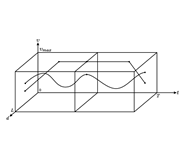Analytical Approximation of Fuel Consumption and Periodic Behaviors for a Vehicle that Travels Through a Traffic Light Series
Main Article Content
Keywords
modeling, simulation, vehicular traffic, fuel consumption, stability analysis, dynamical systems
Abstract
In this paper, we present a piecewise smooth system, that describes the dynamics of a single vehicle moving through a street that has a sequence of lights that turn on and off with a specific frequency. The model presents three dynamic ways: accelerated, decelerated and zero state. Besides, we show the description of the mathematical model used to simulate the system. The simulation was developed under an event-based scheme and implemented in Matlab. To make the numerical analysis, we take as a parameter study the cycle traffic light, which provides benefits to vehicular traffic system due to its configuration is achieved implementing optimization strategies for the phenomenon of green wave and reduces the travel time as the vehicle minimizes the number of stops along the road. Also, the stability was studied for the periodic orbits one and two. Finally, we made an approximation of fuel consumption. We assume that this is proportional to the mechanical energy produced by the motor. From this point of view, it can be concluded that it is possible to apply modeling and simulation strategies based on dynamic systems to understand the complex behaviors associated with the travel of vehicles in a traffic controlled by traffic lights.
Downloads
References
[2] F. Espinosa, C. Gordillo, and O. Avilés, “Algoritmos de visión de máquina aplicados al control dinámico de intersecciones semáforizadas.” DYNA, vol. 80, no. 178, pp. 132–140, 2013. 55, 58
[3] M. Catalano and F. Galatioto, “Enhanced transport-related air pollution prediction through a novel metamodel approach,” Transportation Research Part D: Transport and Environment, vol. 55, pp. 262–276, 2017. [Online]. Available: http://dx.doi.org/10.1016/j.trd.2017.07.009 55, 58
[4] A. Matas, J.-L. Raymond, and A. Dominguez, “Changes in fuel economy: An analysis of the Spanish car market,” Transportation Research Part D: Transport and Environment, vol. 55, pp. 175–201, 2017. [Online]. Available: http://dx.doi.org/10.1016/j.trd.2017.06.025 55
[5] A. D. Marchi, M. Gerdts, and M. Matthias, “Traffic Flow on Single-Lane Road Networks : Multiscale Modelling and Simulation,” IFAC-PapersOnLine, vol. 51, no. 2, pp. 162–167, 2018. [Online]. Available: https://doi.org/10.1016/j.ifacol.2018.03.028 55
[6] J. Mihelj, A. Kos, U. Sedlar, J. Mihelj, A. Kos, and U. Sedlar, “Source reputation assessment in an IoT-based vehicular traffic monitoring system monitoring system,” Procedia Computer Science, vol. 147, pp. 295–299, 2019. [Online]. Available: https://doi.org/10.1016/j.procs.2019.01.267 55
[7] B. A. Toledo, V. Muñoz, J. Rogan, C. Tenreiro, and J. A. Valdivia, “Tráfico Vehicular como Sistema Complejo,” Physical Review, vol. 70, pp. 1–4, 2004. 55, 56, 60
[8] M. Mesa-Mazo, J. Valencia-Calvo, and G. Olivar-Tost, “Modelo para la dinámica de un vehículo a través de una secuencia de semáforos,” DYNA, vol. 81, no. 184, pp. 138–145, 2014. [Online]. Available: http://dx.doi.org/10.15446/dyna.v81n186.39767 55, 57, 60, 62, 64
[9] G. O. Tost, M. Mesa-Mazo, and J. Valencia, “Numerical Simulation Analysis of a Traffic Model,” Springer Proceedings in Mathematics and Statistics, vol. 121, 2015. [Online]. Available: http://dx.doi.org/10.1007/978-3-319-12583-1 55
[10] B. A. Toledo, E. Cerda, J. Rogan, C. Tenreiro, R. Zarama, and J. A. Valdivia, “Universal and nonuniversal features in a model of city traffic,” pp. 1–10, 2007. [Online]. Available: http://dx.doi.org/10.1103/PhysRevE.75.026108 55, 72
[11] A. Varas, M. D. Cornejo, B. A. Toledo, V. Muñoz, J. Rogan, R. Zarama, and J. A. Valdivia, “Resonance, criticality, and emergence in city traffic investigated in cellular automaton models,” Phys. Rev. E, vol. 80, no. 5, p. 056108, 2009. [Online]. Available: http://dx.doi.org/10.1103/PhysRevE.80.056108 56
[12] M. J. Mesa-Mazo, “Bifurcaciones en un Sistema de Tráfico Vehicular,” Ph.D. Thesis, Departamento de Ingeniería Eléctrica, Electrónica y Computación. Universidad Nacional de Colombia, 2014. [Online]. Available: http://bdigital.unal.edu.co/47402/1/7911003.2014.pdf 56, 60, 64
[13] B. Palat and P. Delhomme, “A simulator study of factors influencing drivers’ behavior at traffic lights,” Transportation Research Part F: Traffic Psychology and Behaviour, vol. 37, pp. 107–118, 2016. [Online]. Available: http://dx.doi.org/10.1016/j.trf.2015.11.009 56
[14] M. Makys and S. Kozak, Effective method for design of traffic lights control. IFAC, 2011, vol. 44, no. 1. [Online]. Available: http://dx.doi.org/10.3182/20110828-6-IT-1002.02772 56
[15] B. Davies, Exploring Chaos: Theory and Experiment., P. B. Publishing and . L.L.C., Eds. Perseus Books, 1999. 68, 79
[16] P. G. Lind, “Pattern Formation in Diffusive-Advective Networks of DiscreteTime Oscillators,” Ph.D. Tesis, Universidade de Lisboa 2003. 68, 71
[17] D. C. Lane and J. D. Sterman, “Profiles in Operations Research : JayWright Forrester. Chapter 20 in Profiles in Operations Research: Pioneers and Innovators. S.” Springer, pp. 363–386, 2011. 68
[18] J. a.C. Gallas, “Dissecting shrimps: results for some one-dimensional physical models,” Physica A: Statistical Mechanics and its Applications, vol. 202, no. 1-2, pp. 196–223, jan 1994. [Online]. Available: http://dx.doi.org/10.1016/0378-4371(94)90174-0 71
[19] R. Serway and J. Jewett, FÍSICA para ciencias e ingeniería con Física Moderna, 7th ed., S. R. Cervantes González, Ed. México, D.F.: Cengage Learning Editores, 2008. 72

